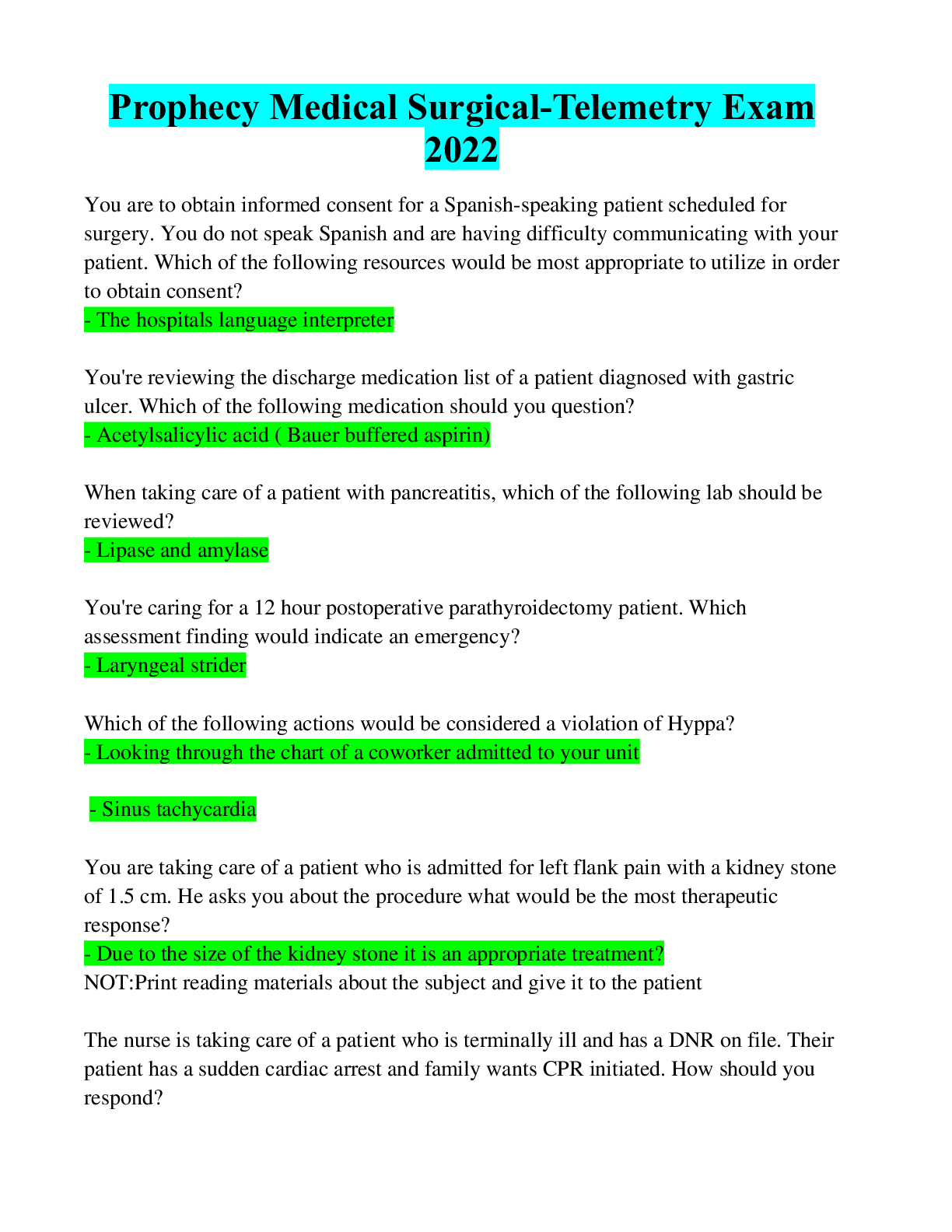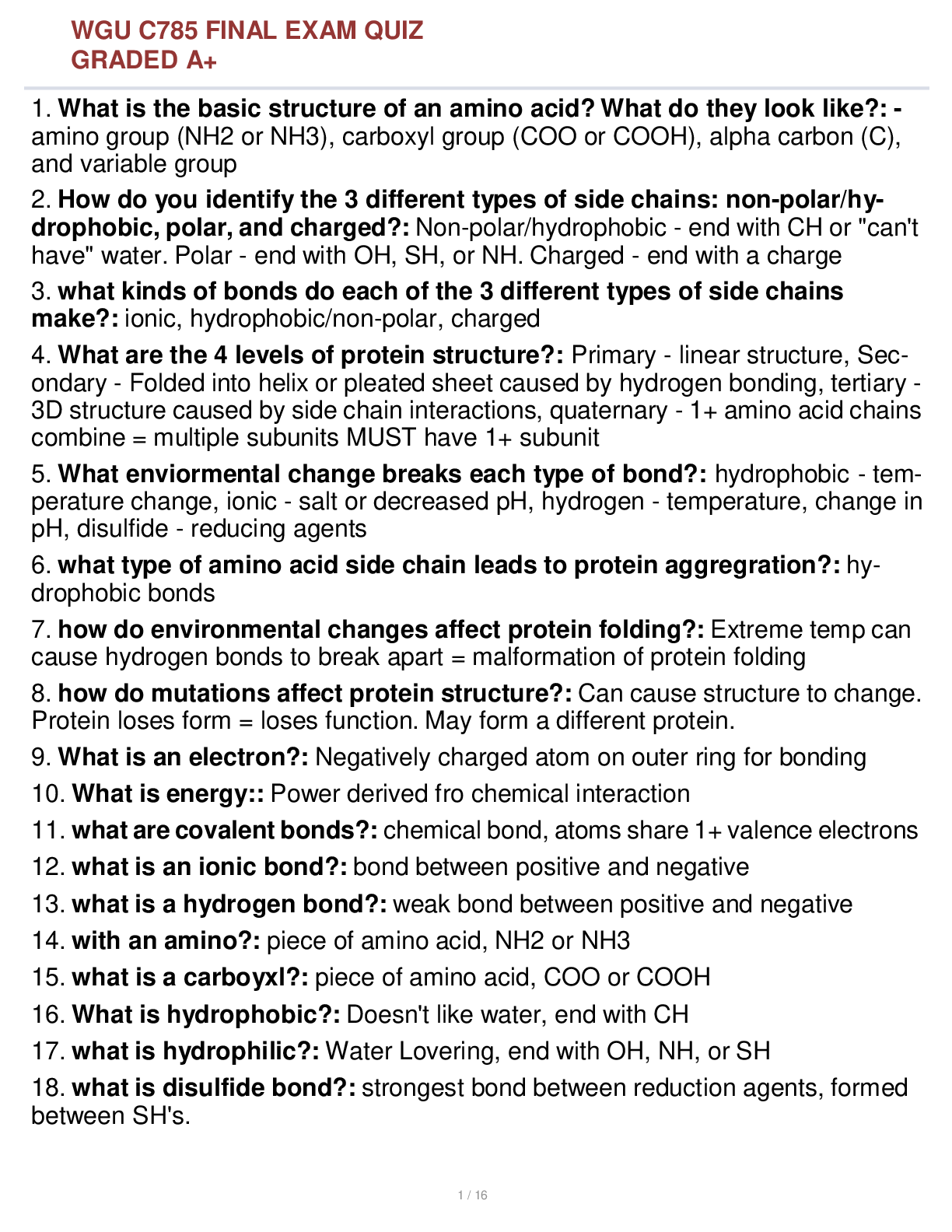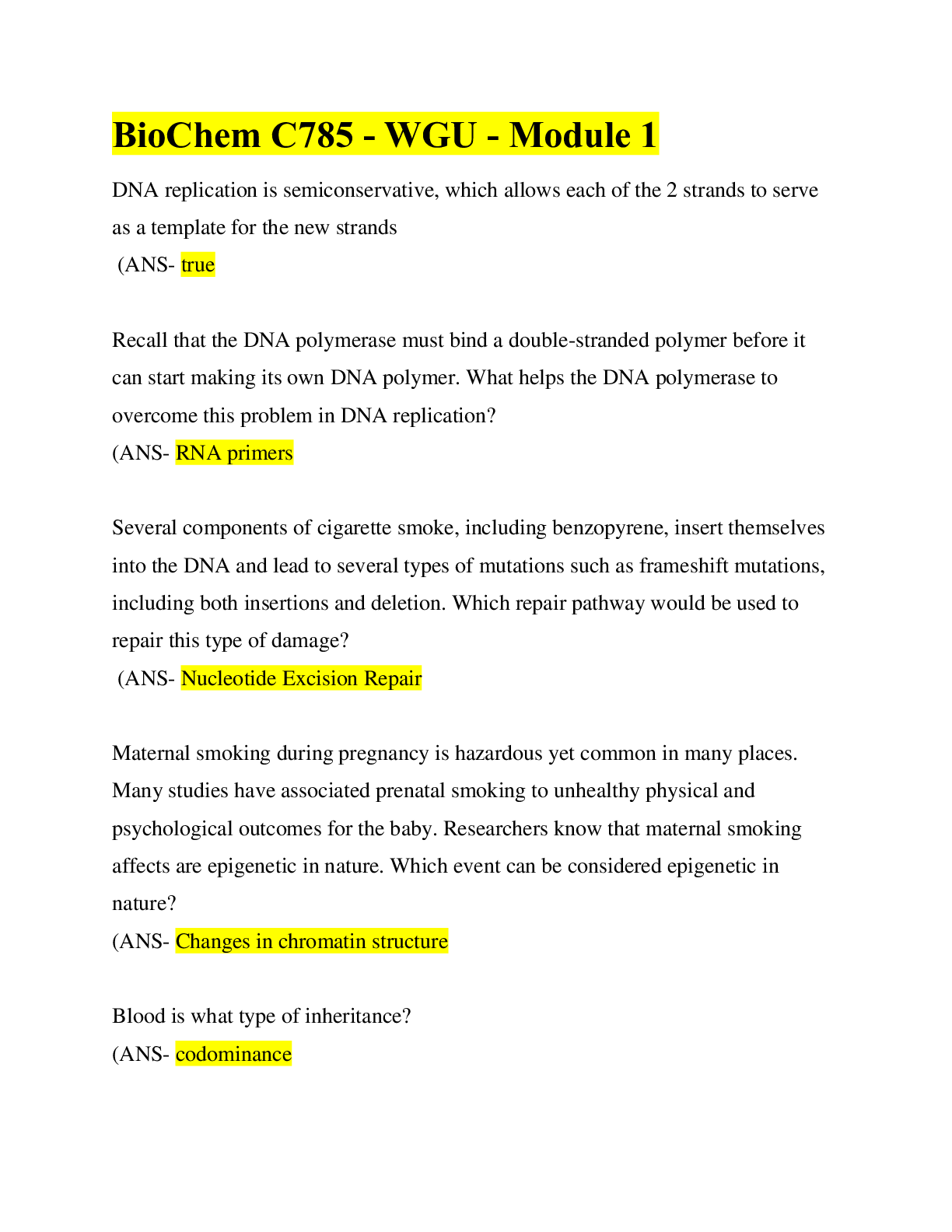Chemistry > STUDY GUIDE > How to Write a Scientific Manuscript (All)
How to Write a Scientific Manuscript
Document Content and Description Below
Guide to Writing a Scientific Manuscript The preparation of a scientific manuscript that describes, documents, and communicates the ideas and information obtained from experimental work, is an inte... gral part of the scientific process. It is through written (and oral) dissemination of results that scientific knowledge advances. Its purpose is to communicate to others the results of an experiment and what the data mean according to the author's interpretation and relate that to previously published data. A scientific manuscript is usually divided into the following sections; Title/author’s name/keywords, Abstract, Introduction, Materials and Methods, Results, Discussion and References/ Literature Cited. A scientific manuscript, like a lab report must be written using the past tense and impersonal tone (avoid “you will”, “I do this”). I- Title page The title should be short and descriptive. It should give the reader a clear idea of the content of the paper. A general title such as "Biology 3050-Lab Report 1" is pointless; it tells the reader nothing about the content of the paper. Example (from Bardin at al., 1996): “A phosphate transport system is required for symbiotic nitrogen fixation by Rhizobium meliloti.” The title must include: 1. Factor(s) manipulated in the experiment – phosphate transport. 2. The focus of the experiment – symbiotic nitrogen fixation. 3. Specific name of subject/organism involved in the experiment – Rhizobium meliloti If possible give the key result of the study in the title (see example above). Author’s name should follow the title. You should also provide five key words that define and/or describe the work performed. These key words are useful when looking for articles in literature databases. See below for examples of key words. 1 Guide to writing a scientific manuscript II- Abstract An abstract is a concise summary of the findings, most often presented as a single paragraph. A reader should be able to read only the abstract and know your objectives, how you accomplished them, what findings you obtained, and the conclusions you drew. It usually consists of a single paragraph containing no more than 250 words and must include: One or two sentences introducing the topic and stating the purpose/objectives (from Introduction). One or two sentences expressing the basic design of the study and describe the key techniques used (from Materials and Methods). The key findings presented in the paper (from Results). This should include a complete summary of quantitative and qualitative findings (support your statements with statistics if applicable). Briefly revisit the purpose/objectives and present Final conclusions/significance of results/future prospects (from Discussion). Example (from Bardin et al., 2004) Seed treatment with non-sterilised powdered straws from 39 crops was tested for the control of Pythium damping-off of sugar beet. Four straws, flax, coriander, pea and lentil were effective in controlling the disease in soil artificially infested with Pythium sp. “group G”. Sterilising flax and pea straws eliminated the control effect of these straws. Wheat straw powder coated on sugar beet seeds increased the incidence of Pythium damping-off but this effect was reversed by the co-inoculation of wheat straws with the biocontrol agent Pseudomonas fluorescens 708. Coating sugar beet seeds with P. fluorescens 708 and flax or pea straws also increased the efficiency of the bacterial strain for the control of Pythium damping-off. Pea straws and to a lesser extent lentil straws produced volatile substances that affected mycelial growth of Pythium sp. “group G” on potato dextrose agar in Petri plates when the straws were mixed with water and left to ferment for two days. Fermentation of pea straws led to the accumulation of volatile ammonia, which was produced by the reduction of the large amount of nitrate stored in the straw. Reduction of nitrate and therefore the release of volatile ammonia did not occur in sterilised pea straws. However, fermenting sterile pea straws with bacteria from different genus restored nitrate reduction and the release of volatile ammonia, suggesting that microorganisms associated with pea straws are responsible for the conversion of nitrate into volatile ammonia which in turn control Pythium damping-off disease in sugar beet. 2 Guide to writing a scientific manuscript The Abstract SHOULD NOT contain: lengthy background information references to other literature abbreviations or terms that may be confusing to readers illustrations, Figures, Tables, or references to them. Final note: The abstract is usually written after the manuscript has been completed since it is a summary of what is presented in the manuscript. To help you write the abstract, you can start by copying key sentences from the different sections of the manuscript. Then organize the sentences in sequence, delete unnecessary details, and connect the sentences to obtain a clear and concise paragraph that accurately summarizes the work presented in the manuscript. As you become more proficient you will most likely compose the Abstract from scratch. III- Introduction An introduction should present the rationale behind the study. Ensure that all of the information you include is relevant to the goal of fully acquainting the reader with the reasoning behind your choices – overall research, specific hypothesis, experimental model, methods etc. This is accomplished by summarizing the current knowledge on the topic being investigated. This section is often completed by a statement of purpose and a brief explanation of the possible outcomes of the study. A. Summary of the current knowledge The introduction begins by providing some background information about the topics presented in the manuscript. Gathering background information means writing a mini-literature review from peer-reviewed journal articles in order to present what was known before your investigation started. You should organize your introduction so that you present the general information first (be careful, avoid being too general; make sure you keep your focus on the topics presented) and then narrow to more specific information. This section should be written so that it leads the reader to the purpose/rational of the experiment. For example, the introduction for the abstract above would start with a description of the pathogen (Pythium sp. Group G, a fungi), followed by a description of the damping-off disease in general and in sugar beet in particular. Then you would described the different ways (reported in the literature) the disease can be controlled and describe more specifically control using biocontrol (the control of the disease by micro-organisms). The use of plant residues for control of plant pathogens in general and 3 Guide to writing a scientific manuscript Pythium in particular would then be reviewed as well as the effect of ammonia released by plants on plant pathogen fungi. When reporting published work, make sure you cite the author(s) and date of the publication as described below: To cite references in the introduction section, simply report the last name of author followed by the date of publication in brackets (John, 2003). If there are two authors, report the name of the two authors followed by the date of publication (Smith and Kenedy, 1999). If there are more than two authors, report the name of the first author followed by “et al.” (in italic) and the date of publication (Conaly et al., 2004). The literature cited in the introduction must be included in the Reference section (see below). Do not cite general background references such as encyclopedias, textbooks, lab manuals, etc, only primary research articles and review articles published in peer-reviewed journals are acceptable. B. Purpose and rational The purpose and rational for the experiment are usually presented in the last paragraph of the introduction. The fact that this section is usually smaller that the first section does not imply that it is less important (some people will argue that this is the most important section of the introduction!). The purpose/hypothesis/question must clearly state what is going to be investigated. Please note that the word “hypothesis” is not desirable in a manuscript. Instead you should write something like: “The purpose of this study was to…” or “This study investigated…” The rational for the experiment might include, but is not limited to, how the study was performed (and how this differs from previous work) and what the possible implications of the study are (why is this important?). Note: Remember that when you submit the introduction, all of the work has been completed. The study is in the past, and so any reference to the experiment, specific findings, decisions made, conclusions drawn, etc. should be made in past tense. IV- Materials & Methods The M&M section describes, in a narrative way, the experimental procedures used to collect the data presented in the manuscript. Each experimental 4 Guide to writing a scientific manuscript procedure or section should be presented as a unit. To do that, each section is organized under a subheading title. Some examples of titles include “Bacterial strains and media”, “Isolation of mutants using UV mutagenesis”, or “Statistical analysis”. The first sentence of each section must explain what this particular procedure is for (for example; Genomic DNA was extracted from peas by…). The description should be detailed enough so that the experiment can be repeated by another scientist. It should therefore contain all pertinent technical details, the instruments used and experimental variables (e.g. temperature, incubation time, masses and volumes, concentrations, voltage, type and % of gel, markers, sizes, centrifuge time and speed, etc). However, DO NOT: mention or describe details of standard and generally known procedures (e.g. size of the flask used; how to use a microscope; how to perform dilutions, etc.). describe instruments when their use is implicit in the methodology described: only report brand names of instruments or supplies when a specific source must be used to ensure the success of an experiment. provide explanation or justification for methods that were used. If a method has been published, you do not need to describe it again; instead, reference the article or book that describes the technique but make sure to include any modifications you may have made to that technique. The difficulty in writing the M&M section comes as you have to decide the level of detail to include. You must determine which details are essential for another investigator to repeat the experiment. For example, if in your experiment you incubate potato pieces in different concentrations of sucrose solutions, it is not necessary to explain that “the pieces were incubated in plastic cups labeled with a wax marking pencil” or to provide the size of the cups. In this case the concentration and volume of the sucrose solutions, the size of the potato pieces and how they were obtained (the variety of potato), and the amount of time the potatoes were incubated are important items to include. When writing a M&M section, make sure you include (when available): Scientific name and source of the organisms used. Types of treatment. Number of replicates. 5 Guide to writing a scientific manuscript Controls used. Variables measured. Source of any specialized reagents or uncommonly used supplies or instrumentation and equipment used (model number and the manufacturer’s name usually written in brackets). Methods of sampling and/or randomization. Specific procedures you developed. The date and location of the sites for field studies. Explain how the data were collected and analyzed (statistical analysis, calculation such as the equation for the calculation of an enzyme activity, etc.). Computer software used. Other Tips for writing a M&M section - M&M is not a laboratory manual or a recipe book. Never use point forms or bullets to write this section. - Be careful not to be too wordy; try to combine several related actions into one sentence. - Avoid using ambiguous terms to characterize treatments such as Tube 1, Tube 2, etc (what do you have in Tube 1, Tube 2?). - Avoid using “then”, “afterwards”, “next”, etc. - Do not start sentences with a verb. - Avoid starting your sentence with a number. V- Results The results section of a report should clearly describe the findings of the study, the general trends and differences, not trivial details. Its primary function is to objectively present your key results, without discussion, in an orderly and logical sequence, using both illustrative materials (tables and/or figures) and text. The Results section should be written in the past tense. The order in which the results are presented should be logical; it should describe the step by step results that allowed the investigators to answer the question posed in the Introduction. Many authors organize and prepare the results section before the rest of the report. A. Text: The written paragraphs are usually divided into subsections with short subtitles. These paragraphs describe the results that are presented in the figures and tables with emphasis on the important findings. Do not describe in words what is already presented in the Tables or Figures. Instead, report 6 Guide to writing a scientific manuscript the significant findings and trends, compare your data points with one another and with the controls, and explain what the data are showing. Refer to each Figure/Table presented in the manuscript by indicating the Figure/Table number (usually indicated in brackets) when describing the corresponding set of data (see examples below): Note: Data points reported in a manuscript are always means of multiple replicates. Variation among the replicates of a treatment must be included by calculating the standard error. The number will therefore be written [Show More]
Last updated: 2 years ago
Preview 1 out of 19 pages

Buy this document to get the full access instantly
Instant Download Access after purchase
Buy NowInstant download
We Accept:

Reviews( 0 )
$8.50
Can't find what you want? Try our AI powered Search
Document information
Connected school, study & course
About the document
Uploaded On
Mar 26, 2021
Number of pages
19
Written in
Additional information
This document has been written for:
Uploaded
Mar 26, 2021
Downloads
0
Views
169








.png)

.png)


